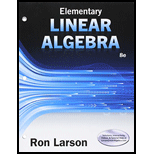
Concept explainers
CAPSTONE
(a) A set
(b) A set
(c) A set
Want to see the full answer?
Check out a sample textbook solution
Chapter 4 Solutions
Bundle: Elementary Linear Algebra, Loose-leaf Version, 8th + MindTap Math, 1 term (6 months) Printed Access Card
- 6. Find the time it will take $1000 to grow to $5000 at an interest rate of 3.5% if the interest is compounded a) quarterly b) continuouslyarrow_forward. Find how many years it takes for $1786 to grow to $2063 if invested at 2.6% annual interest compounded monthly. 12+arrow_forward(1) Let M and N be non-empty subsets of a linear space X, show that whether = U or not, and show that there whether exsits a liear function from P₂(x) into R' which onto but not one-to-one or not. ام (2) Let R be a field of real numbers and P,(x)=(a+bx+cx? / a,b,ce R} be a vector space over R, show that whether there exsit two hyperspaces A and B such that AUB is a hyperspace or not. (3) Let A be an affine set in a linear space X over afield F and tEA, show that A-t is a subspace of Xand show that if M and N are balanced sets then M+N is balanced set. (4) Write the definition of bounded set in a normed space, and write with prove an equivalent statement to definition. (5) Let d be a metric on a linear space X over a field F, write conditions on d in order to get that there is a norm on X induced dy d and prove that. (6) Let M be a non-empty subset of a normed space X, show that xEcl(M) iff for any r>o there exsits yEM such that llx-yllarrow_forwardFind all solutions to the following equation. Do you get any extraneous solutions? Explain why or why not. 2 2 + x+1x-1 x21 Show all steps in your process. Be sure to state your claim, provide your evidence, and provide your reasoning before submitting.arrow_forwardDirections: For problems 1 through 3, read each question carefully and be sure to show all work. 1. What is the phase shift for y = 2sin(2x-)? 2. What is the amplitude of y = 7cos(2x+л)? 3. What is the period of y = sin(3x-π)? Directions: For problems 4 and 5, you were to compare and contrast the two functions in each problem situation. Be sure to include a discussion of similarities and differences for the periods, amplitudes, y-minimums, y-maximums, and any phase shift between the two graphs. Write in complete sentences. 4. y 3sin(2x) and y = 3cos(2x) 5. y 4sin(2x) and y = cos(3x- -플)arrow_forward2. Find the exact value of 12 + 12+12+√√12+ √12+ 12arrow_forwardTechnetium-99m is used as a radioactive tracer for certain medical tests. It has a half-life of 1 day. Consider the function TT where T(d)T(d) =100(2)−d=100(2)−d is the percent of Technetium-99m remaining dd days after the test. Which expression represents the number of days until only 5% remains?arrow_forward1. Find the inverse of f(x) = = 2x 1+2x Then find the domain of the inverse.arrow_forwardLet S = be a set of k vectors in R^, with karrow_forwarda) [1√2-31x+1√3-11y = x (1 - √2) + √34 LI√2-21x-1√3-3/4= √34 - √2x-4arrow_forwardPlease Help me answer this linear algebra question. This is a practice textbook question.arrow_forward1. a scientist observed a bacterium in a microscope. it measured about .0000029 meter in diameter which of the following is closest to it? A- 2 x 10^-6, B- 2 x 10^-5, C- 3 x 10^-5, or D- 3 x 10^-6 2.express the product of 500 and 400 in scientific notation. is it 2 x 10^5 or 2 x 10^4 or 2 x 10^3 or 20 x 10^4arrow_forwardarrow_back_iosSEE MORE QUESTIONSarrow_forward_iosRecommended textbooks for you
- Algebra & Trigonometry with Analytic GeometryAlgebraISBN:9781133382119Author:SwokowskiPublisher:Cengage
 Elementary Linear Algebra (MindTap Course List)AlgebraISBN:9781305658004Author:Ron LarsonPublisher:Cengage Learning
Elementary Linear Algebra (MindTap Course List)AlgebraISBN:9781305658004Author:Ron LarsonPublisher:Cengage Learning Trigonometry (MindTap Course List)TrigonometryISBN:9781337278461Author:Ron LarsonPublisher:Cengage Learning
Trigonometry (MindTap Course List)TrigonometryISBN:9781337278461Author:Ron LarsonPublisher:Cengage Learning  Linear Algebra: A Modern IntroductionAlgebraISBN:9781285463247Author:David PoolePublisher:Cengage Learning
Linear Algebra: A Modern IntroductionAlgebraISBN:9781285463247Author:David PoolePublisher:Cengage Learning Algebra and Trigonometry (MindTap Course List)AlgebraISBN:9781305071742Author:James Stewart, Lothar Redlin, Saleem WatsonPublisher:Cengage Learning
Algebra and Trigonometry (MindTap Course List)AlgebraISBN:9781305071742Author:James Stewart, Lothar Redlin, Saleem WatsonPublisher:Cengage Learning
Algebra & Trigonometry with Analytic GeometryAlgebraISBN:9781133382119Author:SwokowskiPublisher:Cengage Elementary Linear Algebra (MindTap Course List)AlgebraISBN:9781305658004Author:Ron LarsonPublisher:Cengage Learning
Elementary Linear Algebra (MindTap Course List)AlgebraISBN:9781305658004Author:Ron LarsonPublisher:Cengage Learning Trigonometry (MindTap Course List)TrigonometryISBN:9781337278461Author:Ron LarsonPublisher:Cengage Learning
Trigonometry (MindTap Course List)TrigonometryISBN:9781337278461Author:Ron LarsonPublisher:Cengage Learning Linear Algebra: A Modern IntroductionAlgebraISBN:9781285463247Author:David PoolePublisher:Cengage Learning
Linear Algebra: A Modern IntroductionAlgebraISBN:9781285463247Author:David PoolePublisher:Cengage Learning Algebra and Trigonometry (MindTap Course List)AlgebraISBN:9781305071742Author:James Stewart, Lothar Redlin, Saleem WatsonPublisher:Cengage Learning
Algebra and Trigonometry (MindTap Course List)AlgebraISBN:9781305071742Author:James Stewart, Lothar Redlin, Saleem WatsonPublisher:Cengage Learning
